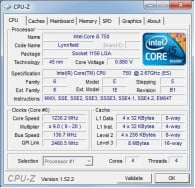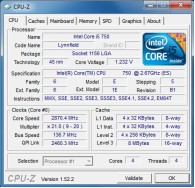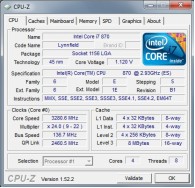Intel Core i5, Core i7 800 Processors and P55 Express
For the purposes of this article, we obtained Core i5 750 and Core i7 870 processors. To get a glimpse of their inner-workings, we first fired up the latest version of CPU-Z and snapped a few images of the pertinent details.



Core i5 750 CPU-Z Processor Details


Core i7 870 CPU-Z Processor Details
Although the chips are quite similar, there are two major differences to point out. First, obviously, are their clock speeds. The Core i5 750's default clock speed is 2.66GHz, the Core i7 870's is 2.93GHz and both chips clock down to about 1.2GHz while idling to save power. The Core i7 750's default clock speed is a result of its stock 20x multiplier and 133MHz base clock frequency (20 x 133MHz = 2.66GHz). The Core i7 870's default clock speed is 2.93GHz, which is a result of its 22x multiplier and similar 133MHz base clock. The second image in each series above, however, shows each chip under a threaded workload, which results in higher frequencies. With Turbo Mode enabled, the Core i5 750 hums along at 2.8GHz, while the i7 870 is at 3.2GHz.
The second major difference is that the Core i7 800 series support Intel's HyperThreading technology, which allows each execution core to processor two-threads simultaneously. As a result, CPU-Z correctly reports that the Core i7 870 and i5 750 feature 4 cores, but that the higher-end i7 870 can process 8 threads, while the Core i5 750 is limited to 4.
Cache configurations on the processors are the same, with 4 x 32K, 8-way associative L1 data caches, 4 x 32K, 4-way associative L1 instruction caches, 4 x 256K 8-way associative L2 caches, and 8MB of 16-way associative L3 caches.
|

Core i5 750 Overclocked To 3.9GHz
Core i7 870 Overclocked To 3.9GHz
We also set out to do a bit of overclocking with the new Core i5 and Core i7 800 series processors, and came away very impressed. We should point out that there are no "Extreme Edition" Core i5 and Core i7 800 series processors, hence they are all multiplier locked for higher values and cannot be manually manipulated upwards to increase clock speeds. The only way to manually increase their frequencies is to increase the base clock speed, which by default runs at 133MHz.
To overclock the Core i5 750 and Core i7 870, we used the stock Intel cooler and a Gigabyte P55-UD6 motherboard. We first increased each processor's voltage to 1.4v and then increased the base clock frequency until our test system was no longer stable. Turbo mode was disabled to prevent any unwanted frequency spikes, but we left HyperThreading enabled on the i7 870. In the end, both chips easily handled 3.9GHz, with the stock cooler.
At 3.9GHz, the chips idled at around 45'C and peaked at over 70'C under load, but they were completely stable. We were also able to boot into Windows at speeds of up to 4.1GHz, but no amount of tweaking with the stock cooler would keep the system stable. With more exotic cooling, however, we suspect stable 4GHz overclocks will be somewhat commonplace with these new chips.






